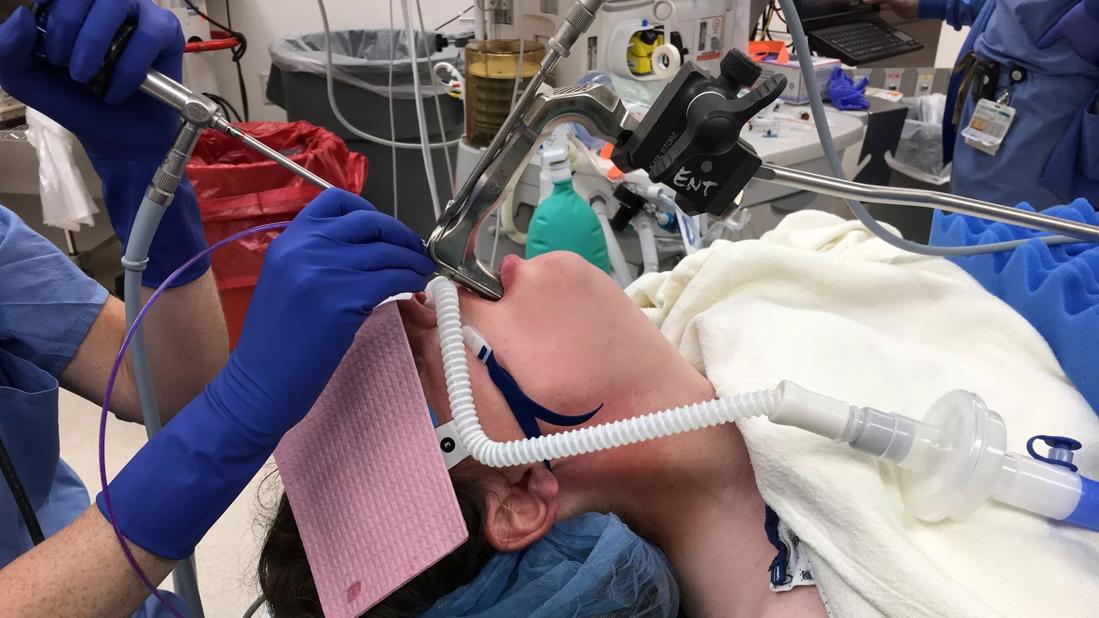The technique comes without many of the drawbacks associated with other ventilation methods

New findings suggest that using high flow nasal oxygen (HFNO) through a specialized nasal cannula, a technique described as: transnasal humidified rapid insufflation ventilatory exchange (THRIVE) could be an effective and safe oxygenation and ventilation technique during microlaryngeal surgery. This technique addresses many of the disadvantages associated with other methods. The study was published in The Laryngoscope.
Advertisement
Cleveland Clinic is a non-profit academic medical center. Advertising on our site helps support our mission. We do not endorse non-Cleveland Clinic products or services. Policy
“These findings further establish this as a reasonable ventilation and oxygenation strategy during anesthesia for patients undergoing microlaryngoscopic surgery,” says Paul C. Bryson, MD, Director of the Cleveland Clinic Voice Center and Section Head of Laryngology and one of the study’s authors. “It’s not a replacement for being prepared with traditional techniques, but it is another strategy that seems to be pretty low risk for patients. For situations where you want to have a little more working time than just the intermittent apnea technique, this seems like a nice option.”
Typically, microlaryngeal surgery requires oxygenation and ventilation via an endotracheal tube (ETT), jet ventilation (JV) or intermittent apnea with an ETT. However, these methods come with significant disadvantages. The ETT often obscures the posterior glottis, JV can cause movement in the structures of the larynx and intermittent apnea leads to frequent interruptions. THRIVE incorporates a device that delivers continuous, warmed and humidified oxygen of varying FiO2 and a high flow rate up to 70 L/min through a nasal cannula.
The present study included patients who underwent microlaryngeal surgery with the THRIVE technique between December 2018 and January 2020. Patients were identified through electronic medical record review.
Patients were premedicated with intravenous (IV) midazolam. After induction of general anesthesia, mask ventilation was instituted for approximately 2 minutes until the muscle relaxant took effect. The mask was then removed and replaced with the high flow cannula, and suspension laryngoscopy was performed. THRIVE was maintained at 70 L/minutes at 100% FiO2. Once the procedure was finished and the suspension laryngoscope removed, an oral airway was applied to keep the airway open while THRIVE was continued as the patient emerged from general anesthesia, says Basem Abdelmalak, MD, FASA, Director of Anesthesia for Bronchoscopy at Cleveland Clinic and study co-investigator.
Advertisement
Patient selection must be thoroughly considered in order to achieve optimal outcomes. In obese patients or those with residual deep neuromuscular blockade, a supraglottic airway was inserted upon removal of the suspension laryngoscope for ventilation during emergence from anesthesia at the anesthesiologist’s discretion. Higher success is expected with patients with BMI <35.
“One of the things, with some patients that are obese or have obstructive sleep apnea, is that you can have some tissue collapse in there, and they’re harder to ventilate in this fashion, just because the pathway for the oxygen isn’t necessarily open,” says Dr. Bryson. “In those patients, you need to be prepared and have all your regular equipment available. You may have less time to do your work, or it just simply won’t provide adequate ventilation.”
A total of 53 patients underwent THRIVE as the sole method of ventilation during the included time period. The majority of patients were female (median age: 51 years; median BMI was 25 kg/m2). Most patients were ASA class 2, and most patients had a Mallampati score of 2. Among these patients, the common surgical indications were subglottic stenosis, vocal fold lesions, and vocal fold paralysis. Median apnea time was 16 minutes. Median end tidal CO2 was 50 mmHG and median minimum SpO2 was 95%. Of the 53 cases, 6 cases required supplementation of THRIVE with JV or tracheal intubation for sustained oxygen desaturation. There was a statistically significant positive correlation between end tidal CO2 at the end of the case and apneic time (P < .02). There was a 0.844 mmHg increase in end tidal CO2 for every minute of apneic time (r2 = 0.25).
Advertisement
Looking ahead, Dr. Bryson notes that while this study focused on adults, other emerging reports discuss the use of the THRIVE technique in children undergoing airway procedures as well as in other settings. Considering COVID-19, “We’re currently in a pandemic with a respiratory virus,” says Dr. Bryson. “It’s unknown to me what, if any, role this plays for those patients who have evolving airway compromise, hypoxemia or need to go to the ICU, but understanding how this technology might improve care for those patients is certainly something worth exploring.” Dr. Abdelmalak adds that the safety of this technique in airway laser surgery is yet to be determined.
Advertisement
Advertisement

Case study illustrates the potential of a dual-subspecialist approach

Evidence-based recommendations for balancing cancer control with quality of life

Study shows no negative impact for individuals with better contralateral ear performance

HNS device offers new solution for those struggling with CPAP

Patient with cerebral palsy undergoes life-saving tumor resection

Specialists are increasingly relying on otolaryngologists for evaluation and treatment of the complex condition

Detailed surgical process uncovers extensive middle ear damage causing severe pain and pressure.

Despite advancements in the specialty, patient-centered care needs to remain a priority